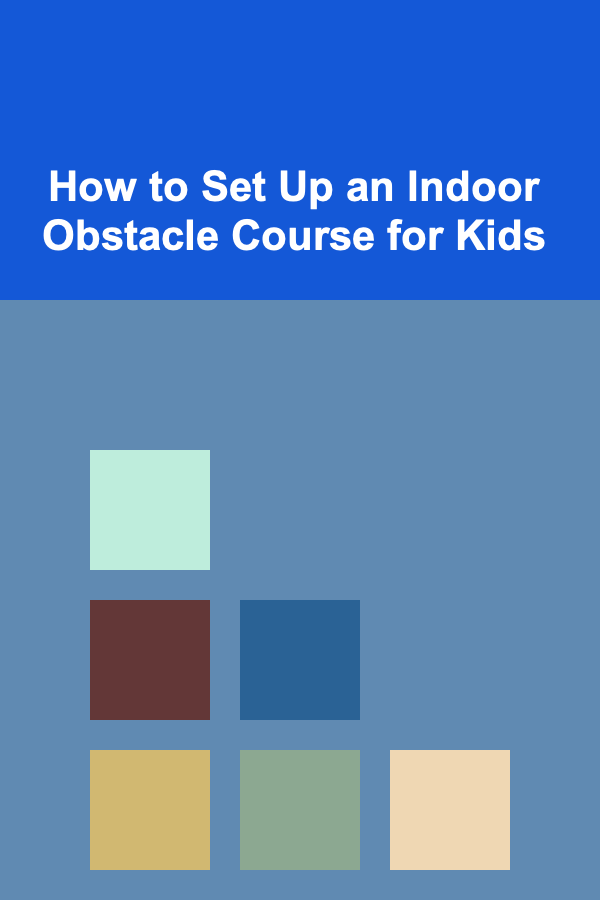
How to Set Up an Indoor Obstacle Course for Kids
ebook include PDF & Audio bundle (Micro Guide)
$12.99$9.99
Limited Time Offer! Order within the next:

Creating an indoor obstacle course for kids is an exciting and innovative way to engage children in physical activity, foster creativity, and develop their motor skills. It provides a fantastic opportunity for both fun and fitness in the comfort of your home, especially when outdoor play isn't an option. Whether you're trying to keep kids active during the colder months, a rainy day, or simply want to offer them a new challenge, an indoor obstacle course is the perfect solution.
In this comprehensive guide, we'll explore the essential steps to set up a fun, safe, and effective indoor obstacle course for kids. From planning the layout to choosing the right materials, and considering the needs of the children, this article will give you all the tools you need to create an engaging experience for your little ones.
Why Set Up an Indoor Obstacle Course?
Before we delve into the specifics of how to create an indoor obstacle course, it's important to understand why this activity can be so beneficial for children. An obstacle course is not just about fun and entertainment; it also serves as an excellent educational and developmental tool.
1. Physical Development
An obstacle course encourages children to move, jump, crawl, balance, and run---all of which help improve their gross motor skills. By challenging their bodies in different ways, kids develop coordination, strength, agility, and flexibility. These physical activities also promote cardiovascular health and help build muscle strength.
2. Mental and Cognitive Skills
Obstacle courses require children to think critically and solve problems. As they navigate through different challenges, kids have to make quick decisions about their next move, which sharpens their cognitive abilities. This kind of physical and mental engagement stimulates brain development, enhancing focus, attention, and decision-making skills.
3. Creativity and Imagination
An indoor obstacle course gives children a platform to use their creativity. They can imagine different themes, such as becoming an explorer, racing through a jungle, or pretending they're secret agents. This imaginative play allows them to tap into their creativity, which is an essential aspect of their emotional and intellectual growth.
4. Social Skills and Cooperation
If the obstacle course is set up for more than one child, it can encourage teamwork and social interaction. Kids often need to work together to navigate the course, helping each other out and collaborating on their strategies. This enhances their ability to communicate, share, and solve problems in a group.
5. Emotional and Psychological Benefits
Completing an obstacle course is an accomplishment that can boost self-esteem and confidence. The sense of achievement that comes from finishing a challenging course can help kids feel more empowered. Additionally, obstacle courses offer a safe space for kids to experiment and take risks without the threat of real harm.
Planning the Layout of the Obstacle Course
The first step in setting up an indoor obstacle course is to plan the layout. The layout will depend on several factors, including the available space, the number of children, their age, and their physical abilities.
1. Assess Available Space
The amount of space available in your home is the first thing you need to consider. An obstacle course can be set up in various rooms, such as living rooms, basements, hallways, or even larger kitchens. The more space you have, the more complex and diverse you can make the course. Ideally, the course should have enough room for the children to move freely without bumping into furniture or causing accidents.
2. Safety First
Safety should always be your top priority when setting up any physical activity for children. Look for sharp corners, fragile objects, or obstacles that could pose a risk. Rearrange the furniture to make room for the course, and remove anything breakable. Ensure the floor is free of obstacles like cords, which could pose tripping hazards. Soft rugs, carpets, or foam mats are ideal to cushion falls and prevent injuries.
3. Age-Appropriate Challenges
Consider the age and ability level of the children who will be using the obstacle course. For younger children, use more straightforward challenges, such as crawling under tables or stepping over cushions. Older children can handle more complex challenges, like jumping over low hurdles, balancing on beams, or climbing over soft structures.
4. Theme and Creativity
Give your obstacle course a fun theme to make it more engaging. You can turn it into a "Superhero Training Camp," where kids have to "jump over lava," or "Spider-Man's Web," where they crawl through a maze of "webs" made from string. Having a theme adds excitement and provides a context that sparks imagination.
5. Variety in Challenges
To keep things interesting, make sure the course has a variety of challenges that incorporate different types of movements. A well-rounded obstacle course will include elements that involve:
- Crawling: Encourage children to crawl under tables or through tunnels made from cardboard boxes.
- Jumping: Set up low hurdles, pillows, or tape lines that children must jump over.
- Climbing: Use furniture like chairs or couches (with cushions added for safety) for climbing challenges.
- Balancing: Use a narrow board, low beams, or even a line of tape on the floor to test their balance.
- Rolling: Rolling over soft mats or pillows can be a fun and active part of the course.
- Throwing or Tossing: Include activities like tossing a bean bag into a bucket or hitting a target with a soft ball.
Materials You Can Use
Now that you have an idea of the layout and types of activities you want to incorporate, it's time to think about the materials. The best part about an indoor obstacle course is that you don't need fancy or expensive equipment. Many items can be repurposed from everyday household objects.
1. Soft Cushions and Pillows
Pillows and cushions are great for creating safe barriers, soft landing areas, or jumping stations. They can also be used as platforms to climb over or balance on. You can pile up cushions to create a low "mountain" for kids to climb or throw soft pillows into a bucket to simulate an "archery challenge."
2. Chairs and Tables
Chairs can be used to create obstacles to climb over or crawl under. Tables can serve as tunnels or platforms to jump onto. Be sure to use sturdy furniture to avoid accidents. You can also use them to create a "tunnel of doom" or a "bridge" challenge.
3. Towels or Blankets
Towels or blankets can be used to create sliding surfaces or paths to crawl through. They can also serve as "lava" for kids to jump over or as a soft landing area.
4. Hula Hoops and Pool Noodles
Hula hoops can be laid on the ground for jumping through, while pool noodles are great for creating hurdles that kids must jump over or crawl under. You can also use pool noodles as balance beams by placing them on the ground or stacking them up.
5. Tape or String
Use painter's tape or string to create lines on the floor for balance challenges or to create a maze for kids to navigate. Tape can also be used to mark jump lines or to create target zones for throwing activities.
6. Cardboard Boxes
Large cardboard boxes can be used to build tunnels or even make structures that kids have to climb over. They're lightweight, easy to rearrange, and add a creative element to the obstacle course. You can also decorate the boxes to match the theme.
7. Balls and Bean Bags
Soft balls, bean bags, or stuffed animals can be used to throw or catch in the course. A tossing challenge or target practice station adds a fun, skill-building element to the course.
Step-by-Step Instructions to Set Up the Course
1. Clear the Area
First, make sure the space is clear of any obstacles or furniture that could cause a safety hazard. If necessary, move or rearrange furniture to create more space for the course.
2. Plan Your Course Layout
Map out the course in your head or on paper before starting to arrange the materials. Decide on the starting point and the finish line, and then determine the obstacles between the two.
3. Set Up the Challenges
Now it's time to begin placing obstacles in the course. Here's an example of how you could structure your course:
- Start Line: Mark the starting point with tape or a rug.
- Challenge 1: Have kids crawl through a tunnel made from a large cardboard box or a blanket draped over two chairs.
- Challenge 2: Set up a series of cushions for kids to jump over.
- Challenge 3: Create a balance beam using a long piece of tape on the floor or a narrow board.
- Challenge 4: Add a tossing challenge, where kids need to throw a bean bag into a container from a certain distance.
- Challenge 5: Set up a climbing station using sturdy chairs or couches.
4. Test the Course
Once everything is set up, test the course to ensure that the obstacles are both safe and challenging. Make adjustments if necessary to avoid accidents or to increase difficulty.
5. Add Finishing Touches
To make the obstacle course even more fun, add themed decorations like signs, banners, or props. You can also set a timer to make it a race against time, or offer rewards for completing the course.
Conclusion
Setting up an indoor obstacle course for kids is an excellent way to keep them active, engaged, and entertained indoors. With a little creativity and some everyday household items, you can create a challenging and fun course that helps develop physical, mental, and social skills. By adjusting the course to suit the age and ability of your children, you'll provide them with a safe and exciting way to expend energy and enjoy themselves---all while developing important life skills. So grab some pillows, chairs, and tape, and get ready to set up a memorable and enjoyable indoor obstacle course today!

How to Seal Gaps and Cracks for Better Soundproofing
Read More
How To Write a Resume That Highlights Remote Work Skills
Read More
How to Collect Environmental DNA (eDNA) for Marine Life
Read More
How To Find TV Shows That Spark Conversation
Read More
How to Use Financial Calculators Effectively
Read More
10 Tips for Photographing Your Toy Collection for Online Sales
Read MoreOther Products

How to Seal Gaps and Cracks for Better Soundproofing
Read More
How To Write a Resume That Highlights Remote Work Skills
Read More
How to Collect Environmental DNA (eDNA) for Marine Life
Read More
How To Find TV Shows That Spark Conversation
Read More
How to Use Financial Calculators Effectively
Read More